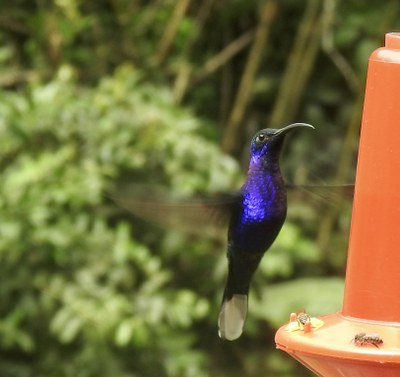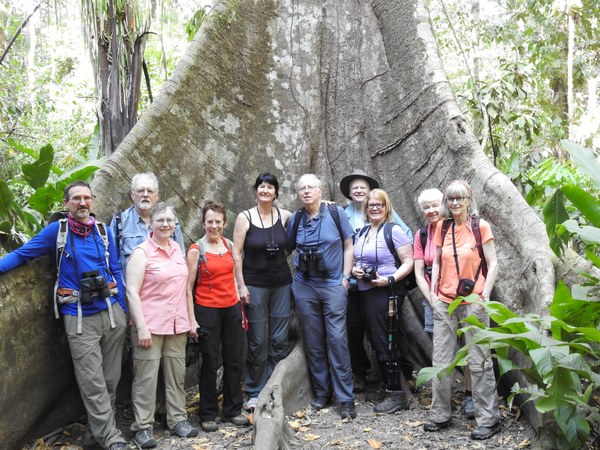
Trip Report
Hike and Photograph in Costa Rica Where Nature is Its Colorful Best!
The Central Pacific Region of Costa Rica which encompasses a variety of habitats distributed in different zones of life from the ocean level up to 3000 ft. We explored the area to observe and take pictures of birds, plants, animals, insects and the food of the region.
- Wed, May 8, 2019
- Hike and Photograph in Costa Rica Where Nature is Its Colorful Best!
- Photography & Day Hiking
- Successful
-

- Road suitable for all vehicles
-
The roads were mostly paved and narrow. The hiking trails were strenuous in many places. The trails for observation of nature were beginner trails like the lowland trails in the Cascades.
COSTA RICA March 23 - April 3, 2019

The first Global Adventures trip to Costa Rica was way beyond expectations by everyone. The trip was planned for 12 Mountaineers but 2 people had health problems at the last minute and canceled. The group of 10 consisted of: Dave and Betsy Schultz, Dave Claar and Patti Polinsky (leader) Margaret and Gary Salmi, Frank Albano, Alice North, Sue Hays and Kristi Hansen. We had Federico Albán as our “above” expectations Naturalist and photographer, and “Shampoo” our driver for the complete trip.
The Central Pacific Region of Costa Rica which encompasses a variety of habitats distributed in different zones of life from the ocean level up to 3000 ft.
We began our trip with a day of relaxation at the Bougainvillea hotel which overlooked San Jose on 10 acres of gardens teaming with birds, flowers, wildlife and beautiful retreats nestled throughout the garden. The group arrived at least one day ahead of the official start of the trip to relax to become accustomed to the “no-hurry” attitude of Costa Rica.
Sunday morning Federico arrived at 7 AM to lead us into the mountains to La Plan Waterfall and sanctuary to be able to observe birds close-up that we might see in the wild and the “cats of Costa Rica” we probably would never see even on a “night” walk. After our first typical Costa Rican lunch and a walk down beside the waterfall we were off to experience all of Costa Rica in 9 precious days of our life!
Parasol Mushrooms
Aguti Katydid
Black-checked Turquoise Brow Mutmut
Woodpecker
miniature orchid
Baby Holler Monkey
We started in the Sarapiqui Region at the La Quinta Lodge on the Caribbean side of Costa Rica in the rain forest (no rain!) where birds, animals, trees and flowers present opportunities for extended exploration. We were spell-bound early in the morning as we sat near a the feeding station to observe our first taste of the kaleidoscopic bright colored birds.
We visited La Selva, a biological research station and reserve, at night and again the next morning. Guided by La Selva guides, we saw the biodiversity of lowland tropical rainforest. These specialized guides, one week earlier, had discovered where seven white cotton ball bats were sleeping. The bats had cut a leaf to make a tent so they had a house to sleep in during the day. We learned to look for peccary (wild pigs) from their unique smell which infiltrated the air when disturbed accompanied by loud rolling growl! Over 300 species of birds have been identified at La Selva. Here we were introduced to unique birds of this area, but the leaf cutter ants marching in-line on their very distinct, inches wide, highways. Near by were bullet and solider ants.
As many of the animals live high above the ground, we rode the Rainforest Aerial Tram 30 feet above sections of the forest to see Guans and Toucans. The gardens around the tram were teaming with beautiful flowers and again more unique birds and animals of this area. On a strenuous hike down to the river where ate lunch, we found a complete skin of a snake which had been shed shortly before our arrival and the foot print of a wild catl!
To explore another eco-system of Costa Rica, we moved to the Caribbean Watershed of the Central Volcanic Mountain Range Cloud Forest area around Bosque d Paz, This is a small private reserve, Bosque De Paz Reserva Biológica, was the most unique part of this adventure. It was so unique to be the the only group here to explore this private reserve with Federico. We stayed in buildings made from trees which had fallen on the property and then milled to build the buildings. The chef prepared meals using herbs and vegetables from gardens on the property in traditional Costa Rican dishes. During dinner Federico, the owner, would light the far side of meadow for a very brief moment so we could see the animals of the night which we never expected to see except in books!
Since Costa Rica formed 26 national parks in 1978 to preserve the natural environs. Individuals have purchased land to extend protected lands. Two Americans purchased 257 acres to preserve the primary and secondary forests as a biological preserve. This preserve is restricted to scientific field-research led by the Nectandra Institute. We were guided by the owners who had spent over 5 years to prepare the area for research and visitors such as our small group. The pink katydids was the first observation for the owners and for us.
Exploration of the Central Pacific Region encompassed a variety of habitats distributed in different zones of life from the ocean level up to 3000 ft. This was an overlapping area where the northern hemisphere flora & fauna meets the southern hemisphere species. We stayed in bungalows of Cerro Lodge as a base to spend the morning exploring Carcara National Park which is located between the dry forests of the north and the humid areas of the south. From the porch of the bungalows we saw iguanas on the ground, screeching red macaw parrots over head and holler monkeys high in the trees were heard. Our bungalows had a private outside bathroom. It was an experience to take the shower outside with the melodious blackbird overhead singing.
We experienced the warmth and humidity of the Pacific ocean. We spent the early morning, when the heat was less and the chance to see animals and birds much more likely, walking through a small section of Carara National Park where we were amazed by the large, outreaching bases of the mahogany trees.
After lunch and a rest at Cerro Lodge, we had a private boat tour on the Tarcoles River, one of 4 rivers flowing into the Nicoya Peninsula. Although the river is known for the large crocodile population, some which are 15 ft long, we saw not a few but were rewarded with spotting of several bird families we had not seen before. Especially striking was the Turquoise Mutmut with its long tail and the male and female pigmy kingfishers.
We then took most of the day to return to San Jose, stopping along the way to enjoy cultural experiences of Costa Rica.
The next morning at 5:30 am we left on a privately booked one-day tour to Tortuguero National Park located on the Caribbean side of Costa Rica. This park has no roads to it. There is no internet and no cars in this national park. You must either come via boat or fly in a small sea plane.
We returned to SanJose to have dinner with the Costa Rician people who had made this tour such an experience, Elena from Costa Rica Expeditions, Federico, the naturalist/photographer and his partner and all our group.
Another trip is planned for September, 2020, to all new areas, new unique animals and birds and to see the turtles lay eggs and see the eggs hatch.
Farmer’s Market in Zarcero
Black-checked Woodpecker
 Patti Polinsky
Patti Polinsky
 Trevor Dickie
Trevor Dickie